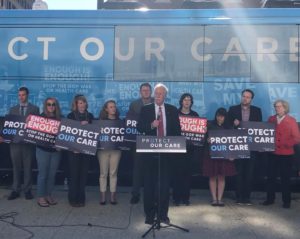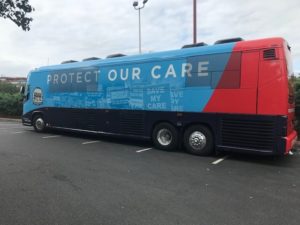“Care Force One” Makes Stop in Portland on National Bus Tour

Portland, Maine – Today, Senator Angus King and Congresswoman Chellie Pingree (ME-01) joined state representatives and three Mainers with pre-existing conditions at Portland City Hall to speak out against the devastating repercussions of health care repeal.
Today, Senator Angus King and Congresswoman Chellie Pingree (ME-01) joined state representatives and three Mainers with pre-existing conditions at Portland City Hall to speak out against the devastating repercussions of health care repeal.
The event was part of Protect Our Care’s nationwide bus tour calling attention to Republicans’ attempts to sabotage health care, including a lawsuit signed onto by Governor Paul LePage that would gut protections for Mainers with pre-existing conditions.
The 548,000 Mainers living with a pre-existing condition would be in jeopardy if a judge sides with Paul LePage, President Trump, and the GOP in their lawsuit. What’s more, 70,000 Mainers have been denied access to affordable health coverage through Governor LePage’s refusal to expand Medicaid.
Senator Angus King kicked off the event, saying, “What worries me is that there’s this ongoing effort to undo the advances made by the Affordable Care Act. And make no mistake, the Affordable Care Act is not collapsing – it’s being mugged. We’ve been able to beat back these repeal efforts in the past, and we need to continue to do so.”
“The Republicans in Congress and this administration have been destroying the ACA. They couldn’t repeal it, so they’ve just been trying to destroy it,” Congresswoman Pingree echoed. “Almost half of the state of Maine has one pre-existing condition, and we want to make sure they have the care they need, so we are going to continue to fight very hard on this.”
They were joined by State Rep. Heather Sanborn, State Rep. Matt Moonen, and Mainers living with pre-existing conditions, who shared their stories and talked about the protections provided to them under the Affordable Care Act.
“The stakes have never been higher for Mainers’ health care,” said TJ Helmstetter of Protect Our Care. “Since the enactment of the Affordable Care Act, almost 70,000 Mainers have gained health insurance. This is all in jeopardy due to Republicans’ repeal and sabotage agenda, including Governor LePage’s ludicrous lawsuit and Rep. Poliquin’s vote to repeal health care. Mainers want this Republican war on health care to end, plain and simple. That’s why we’re here today.”
You can watch the full video here. The bus travels to Bangor this afternoon, then onto New York. More details but upcoming stops can be found here.






